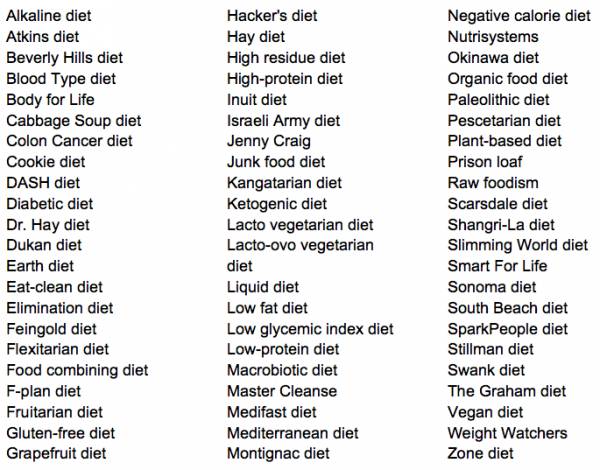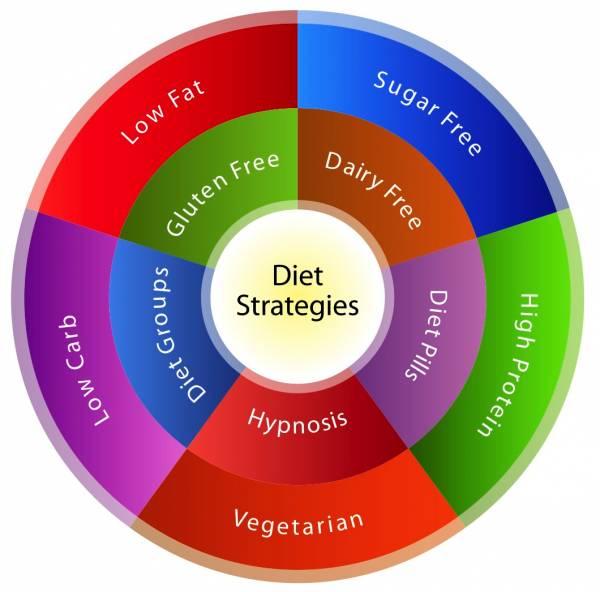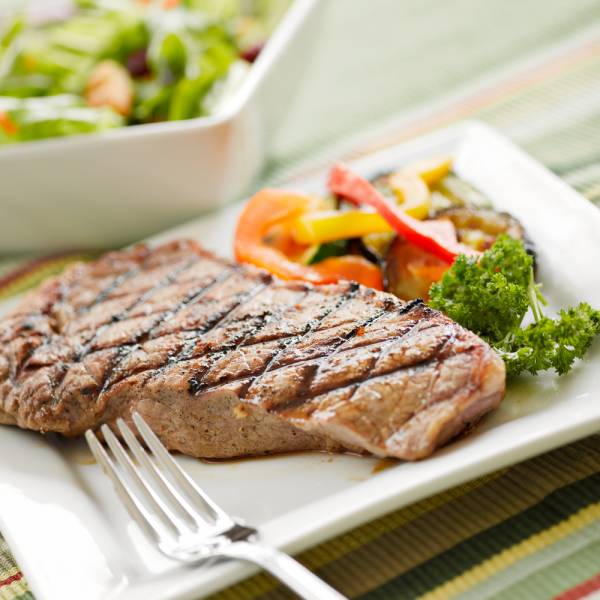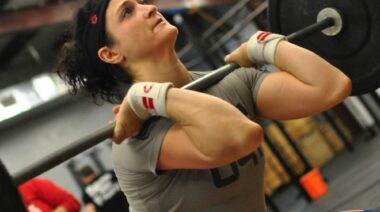Let’s set the record straight from the outset: the goal of any weight loss, pound-shedding, “trimming,” or whatever-you-label-it program is body FAT loss, not necessarily scale-weight loss. So, bubble-wrap your weight scale and put it in the basement or attic and focus on your body composition: the fat to muscle ratio.
Let’s set the record straight from the outset: the goal of any weight loss, pound-shedding, “trimming,” or whatever-you-label-it program is body FAT loss, not necessarily scale-weight loss. So, bubble-wrap your weight scale and put it in the basement or attic and focus on your body composition: the fat to muscle ratio.
Opinions abound on the best way to lose body fat. For those seeking a special diet, check out the partial list of what’s out there:

No wonder many are confused. Which one is the easiest to follow? Which one is financially affordable? Which one is the most effective? Ultimately, which one will help me lose fat? Yikes.
I am not a Registered Dietician so I cannot offer you specific advice on what you should be consuming. I will, however, lay out bits and pieces of some of the most recent issues and arguments in the fat loss world, such as:
- Is it simply creating a calorie deficit, so your body is forced to tap into adipose fat?
- Is a calorie a calorie regardless if it comes from protein, carbohydrate, or fat?
- Regarding the last question, what is better: a high carb/low fat or a low carb/high protein diet?
- What about the glycemic content of carbs and blood sugar levels?
Calorie Deficit
There is no question that a reduction of calorie intake coupled with high-level energy expenditure results in weight loss (all other factors being equal). But what guarantees the weight loss to be fat only? Consider these facts:1
- It is a long-standing fact that a pound of fat equals 3,500 calories.
- A pound of muscle renders around 600 calories.
- People with a higher percent of body fat will lose more fat and retain more muscle with a significant calorie deficit.
- People with a lower percent of body fat will lose more muscle and retain more fat with a significant calorie deficit.
Let’s do some math. A 500 calorie deficit per day over one week could result in two outcomes: a loss of one pound of fat (3,500/3,500 calories = 1) or a loss of nearly six pounds of muscle (3,500/600 calories = 5.8).
Obviously, the loss of muscle is not desirable. This is why attention must be paid to the correct calorie deficit based on your existing percentage of fat and your activity level. If you possess a significant amount of body fat, you can probably get away with a larger deficit in the early stages.
As you become leaner – or if you are relatively lean to begin with – the calorie deficit needs to be adjusted to preserve lean tissue. This also explains why it is so difficult to shed those elusive few pounds to get completely “ripped.”
Calories from Proteins, Carbs, and Fats: Is There a Difference?
Regarding the first law of thermodynamics, a calorie is a calorie. That is, no matter what source it is from, one calorie is the energy required to increase the temperature of one kilogram of water by one degree Celsius. Energy can be neither created nor destroyed. It can only be transformed.

Here’s a little bit of historical science behind the accepted caloric value of protein, carb, and fat in the diet. The past work of Rubner and Atwater is the standard used today.
Using a bomb calorimeter to measure the heat of combustion of various proteins, carbs, and fats, they determined the energy density of dietary protein = 4.1 calories/gram, carbs = 4.1 calories/gram, and fat = 9.3 calories.
Rounded off, it is 4 calories/gram of protein, 4 calories/grams of carbs, and 9 calories/gram of fat that we currently use (and why many panic when they see fat is more than double in potency).
Past thinking was to eat .7 to 1.0 grams of protein per pound of body weight, load up on the carbs for energy, and minimize the fat. After all, 15 grams of fat has 135 calories and 15 grams of carbs has only 60, so to help shed the pounds, back off on the fat intake. But it’s not that simple. The type of protein, carb, and fat must be considered as well as how the body processes them.
High Carb/Low Fat or Low Carb/High Protein?
A review was conducted that evaluated studies comparing weight loss and energy expenditure in adults consuming high protein and/or low carbohydrate with low fat diets. I believe this is where all the support for low carb diets got its momentum.
The review analyzed nine studies where diets composed of high protein and/or low carbs resulted in a 5.5 pound greater weight loss after twelve weeks as compared to diets of high carbs and/or low fat.
However, neither macronutrient-specific differences in the availability of food energy nor changes in energy output could explain these differences in weight loss.If a calorie is a calorie, then what other factors could account for the differences in weight loss between the two diets?
Low carb diets facilitate the loss of glycogen stores and associated water, which can be as great as 4.4 pounds.

Because the Rubner and Atwater factors used to calculate metabolizable energy are not exact, the standard macronutrient values are not perfect, and small errors can occur.
The substitution of one macronutrient for another has been shown in some studies to be statistically significant regarding the effect on the expenditure half of the energy balance equation, especially in high-protein diets.
Because the energy expenditure is minimal, however, it may account for less than one-third of the differences in the weight losses reported between high-protein or low-carb diets and high-carb or low-fat diets.
Carb Glycemic Level and Blood Sugar Stabilization
In general, high glycemic carbs create a large, temporary rise in blood sugar (glucose) because they are quickly digested. Low glycemic carbs take longer to digest, thus produce a smaller and slower rise. A rapid rise in blood sugar means:
- More insulin is released. A high insulin level promotes a quick storage of sugar in muscle and the liver. It also inhibits the hormone glucagon, which normally tells the body to burn stored fat. Obese people tend to be “sugar burners”– they mainly burn stored glycogen. Their forthcoming meals restore glycogen (especially if high glycemic) and the cycle keeps repeating. Thus, fat stores do not get touched and usually grow larger.
- Blood sugar levels then drop quickly, leaving you hungry sooner. Suddenly, the body needs more fuel. But because glucagon is still in short supply, the body does not tap into its fat supply for energy. The inevitable result? Hunger. You will eat again, needlessly, which can lead to increased fat gain over time.
Facts to consider:2
- Highly processed foods that contain refined sugars (cookies, crackers and corn syrup) usually have a higher glycemic level.
- Other factors affecting the glycemic level is whether the food is liquid or solid, raw or cooked, and the amount of fiber it contains.
- The more grams of carbohydrate consumed the higher the glycemic response because there is an increased glycemic load. So, one can over-consume even low glycemic foods.
- Most people usually eat foods in combination. The fat and protein also consumed at feedings can help lower the overall glycemic level.
- Not all simple sugars are high glycemic. Fruit, for instance, contains the simple sugar fructose. Fructose has a slow rate of digestion and absorption and thus a lower glycemic response.
Moderate and high glycemic foods are recommended during and after exercise. Consuming a high glycemic food within 45 minutes after exercise elevates plasma glucose concentrations and facilitates muscle glycogen replenishment.
Post-exercise insulin secretion increases protein synthesis by increasing amino acid uptake in the muscles. Insulin also enhances blood flow into muscle, thus facilitating the removal of lactate and carbon dioxide.
Final Thoughts
Information abounds on all aspects of fat loss. Who and what can you believe?
My advice would be to consult a registered dietician or a nutrition specialist for specific diet recommendations based on your fat loss goals.
Even if your goal is to gain weight (muscle), there are certain dos and don’ts the dietician can address.
Now you now how to eat for fat loss – find out how to exercise for fat loss.
Photos courtesy of Shutterstock.






